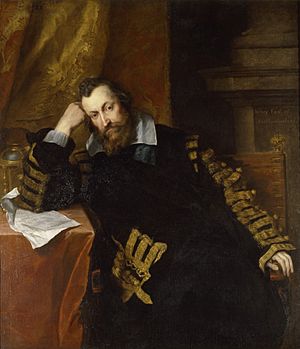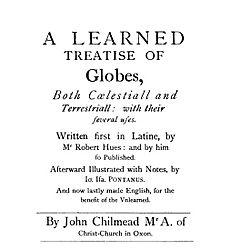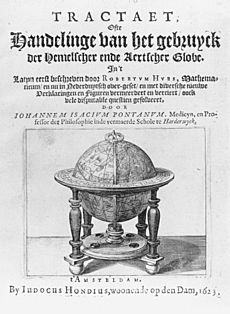Robert Hues facts for kids
Quick facts for kids
Robert Hues
|
|
|---|---|
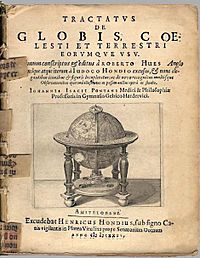
The title page of a 1634 version of Hues' Tractatus de globis in the collection of the Biblioteca Nacional de Portugal
|
|
| Born | 1553 Little Hereford, Herefordshire, England
|
| Died | 24 May 1632 (aged 78–79) Oxford, Oxfordshire, England
|
| Alma mater | St Mary Hall, Oxford (BA, 1578) |
| Known for | publishing Tractatus de globis et eorum usu (Treatise on Globes and their Use, 1594) |
| Scientific career | |
| Fields | Mathematics, geography |
Robert Hues (born 1553 – died 24 May 1632) was an English mathematician and geographer. He studied at St. Mary Hall at Oxford and finished his degree in 1578.
Hues became very interested in geography and mathematics. He even studied navigation at a special school started by Walter Raleigh. During a trip to Newfoundland, he noticed things that made him wonder if the compass readings were always right.
Between 1586 and 1588, Hues sailed around the world with Thomas Cavendish. On this trip, he studied the stars and figured out how far north or south they were at different places. In August 1591, Hues and Cavendish started another trip around the world. Hues continued to study the stars in the South Atlantic and watched how the compass changed at different places, including the Equator. Cavendish sadly died on this journey in 1592, and Hues returned to England the next year.
In 1594, Hues shared his discoveries in a Latin book called Tractatus de globis et eorum usu (which means Treatise on Globes and Their Use). This book was written to explain how to use the Earth and sky globes made by Emery Molyneux. It also aimed to help English sailors use the stars to find their way. Hues's book became very popular and was printed at least 12 more times in different languages like Dutch, English, French, and Latin.
Hues continued to work with Raleigh in the 1590s. Later, he worked for Thomas Grey, 15th Baron Grey de Wilton. When Grey was held in the Tower of London, Hues stayed with him. After Grey died in 1614, Hues helped Henry Percy, the 9th Earl of Northumberland, who was also in the Tower. Hues taught Northumberland's son, Algernon Percy, at Oxford. Later, he taught Algernon's younger brother, Henry. In his later years, Hues lived in Oxford and talked about math with his friends. He passed away on May 24, 1632, and was buried in Christ Church Cathedral.
Contents
Early Life and Learning
Robert Hues was born in 1553 in Little Hereford, England. In 1571, when he was 18, he started at Brasenose College at the University of Oxford. An old writer named Anthony à Wood said that Hues started as a "poor scholar" but later moved to St Mary's Hall to focus more on his studies.
Hues earned his Bachelor of Arts (B.A.) degree on July 12, 1578. He was very good at Greek. He even gave advice to the writer George Chapman for his 1616 English translation of Homer. Chapman called him his "learned and valuable friend." Some records suggest Hues might have been held in the Tower of London after his degree, but we don't know why. He might have traveled to Continental Europe after being released.
Hues was friends with the geographer Richard Hakluyt. In the 1580s, Hakluyt introduced him to Walter Raleigh and other explorers and navigators. Hues also likely met the astronomer and mathematician Thomas Harriot and Walter Warner. These four men later worked with Henry Percy, the 9th Earl of Northumberland, who was known for his interest in science.
His Work and Journeys
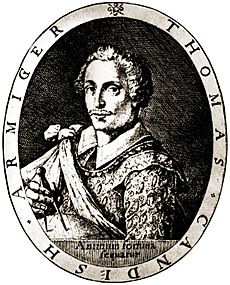
Hues became very interested in geography and mathematics. He noticed that the readings of a compass seemed to change when he was off the coast of Newfoundland. He might have gone there on a fishing trip or with a voyage to Virginia in 1585. Hues probably met the sailor Thomas Cavendish around this time, as both of them learned from Harriot at Raleigh's navigation school.
An old paper says that Hues sailed around the world with Cavendish between 1586 and 1588. His goal was to find the exact Latitude (how far north or south a place is) of different locations. In 1589, Hues also joined an expedition to the Azores to capture Spanish ships.
In August 1591, Hues joined Cavendish on another trip to sail around the world. They sailed on a ship called the Leicester, along with explorer John Davis on the Desire. The trip did not go well. They faced cold weather, illness, and hunger. Cavendish decided to turn back to England. He also had problems with his crew and attacks from native people and the Portuguese.
During this journey, Hues studied the stars in the Southern Hemisphere, like the Southern Cross, while in the South Atlantic. He also kept observing how the compass changed there and at the Equator. He returned to England after Cavendish died.
The Book on Globes
Hues published his discoveries in his book, Tractatus de globis et eorum usu (Treatise on Globes and Their Use), in 1594. He dedicated the book to Raleigh. The book was written to explain how to use the Earth and sky globes that Emery Molyneux had made. It also aimed to encourage English sailors to use the stars and globes to navigate.
The book was written in Latin, which suggests it was also for scholars in other countries. In 1595, a merchant named William Sanderson, who helped pay for the globes, gave a small globe and Hues's book to Robert Cecil, a powerful government official. Hues's book was printed many times in different languages, showing how important it was. Even John Smith, who founded the first English settlement in North America, suggested young sailors should read Hues's book.
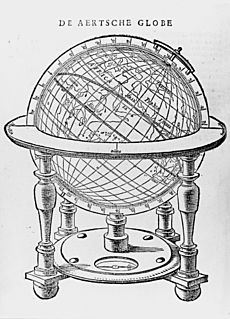
Tractatus de globis starts with a letter from Hues to Raleigh, talking about the discoveries made by English explorers. Hues believed that if English sailors knew more about astronomy and geometry, they would be even better than Spanish and Portuguese sailors. In the beginning of the book, Hues explained why the Earth is a sphere and argued against other ideas.
The book had five parts:
- The first part described parts common to both Earth and sky globes, like the lines and circles on them.
- The second part described planets, fixed stars, and constellations.
- The third part described the lands and seas on the Earth globe, and talked about the size of the Earth.
- The fourth part, which Hues thought was the most important, explained how sailors could use the globes to find the sun's position, their location (latitude), their direction, and the time.
- The last part was about rhumb lines, which are lines of constant compass bearing.
In his book, Hues also shared six important rules for navigation, which helped sailors figure out their position and direction using a "nautical triangle."
Later Connections
In the 1590s, Hues continued to work with Raleigh. He later became a helper for Thomas Grey. Grey was put in the Tower of London for being part of a plan against King James I. Hues was allowed to stay with him in the Tower. From 1605 to 1621, Northumberland was also held in the Tower. He was suspected of being involved in the Gunpowder Plot.
After Grey died in 1616, Hues started working for Northumberland, helping him with his studies. He was paid to support his research until Northumberland's death in 1632. Some people said that Harriot, Hues, and Warner were Northumberland's "constant companions" and were called his "Three Magi" (wise men). They studied science and math together. Hues taught Northumberland's sons, Algernon Percy and his younger brother Henry, at Oxford. Hues lived at Christ Church at this time.
Final Years
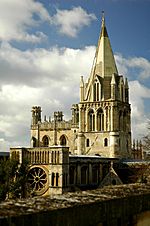
In his later years, Hues lived in Oxford. He often talked about mathematics and related topics with his friends. He was a fellow (a senior member) at the University. When Thomas Harriot died in 1621, Hues and Warner were asked to help prepare Harriot's math papers for publishing. Hues also helped value Harriot's books for sale to the Bodleian Library.
Hues never married. He died on May 24, 1632, in Oxford. In his will, he left small gifts to his friends and family.
Works
- Tractatus de globis et eorum usu (Treatise on Globes and Their Use), 1594 (in Latin). This book had many reprints, including:
- 1597 (in Dutch)
- 1611 (in Latin)
- 1618 (in French)
- 1638 (in English), titled A Learned Treatise of Globes, both Cœlestiall and Terrestriall: With their Severall Uses.
- 1659 (in Latin and English)
- 1663 (in Latin)
Images for kids
See also
 In Spanish: Robert Hues para niños
In Spanish: Robert Hues para niños


